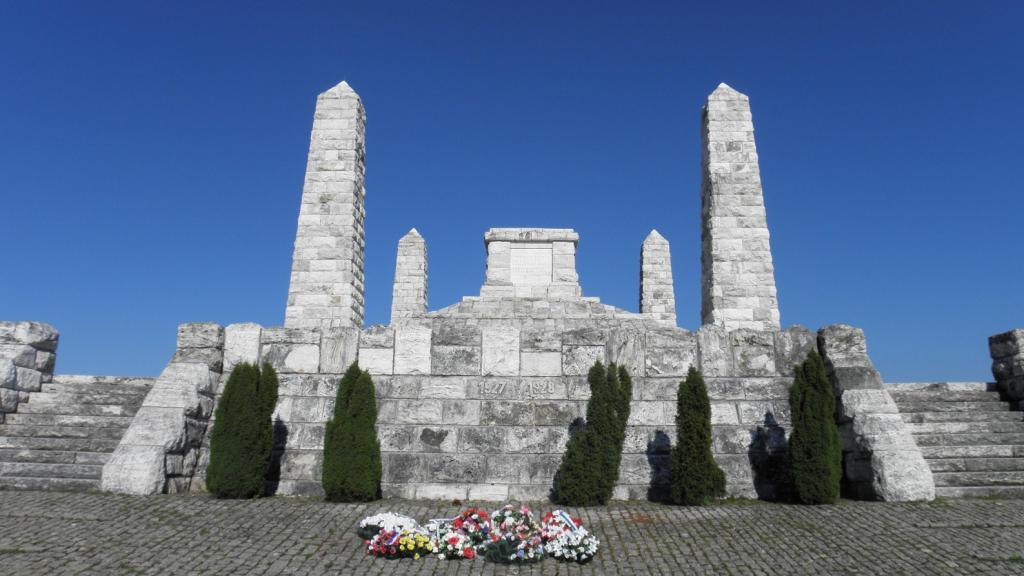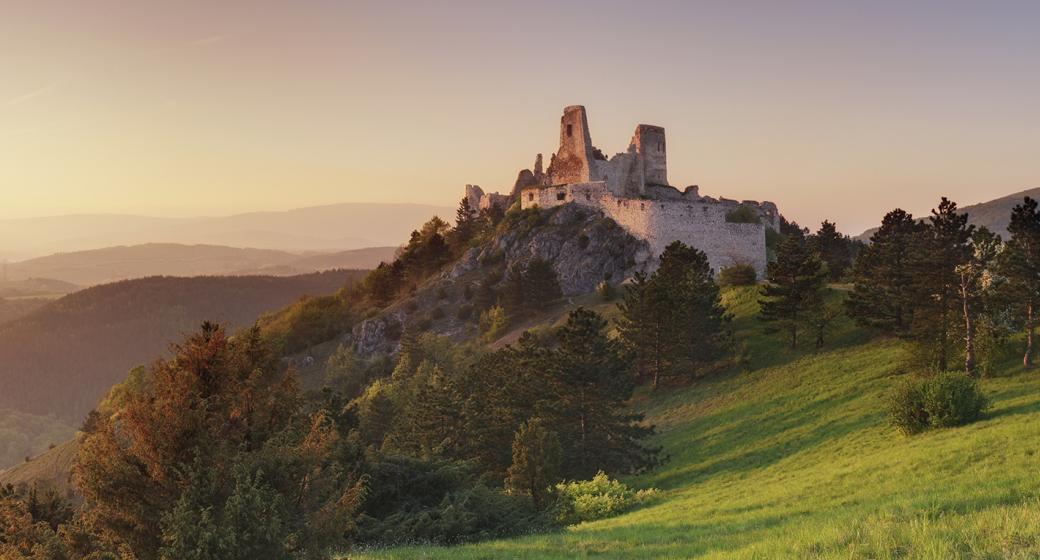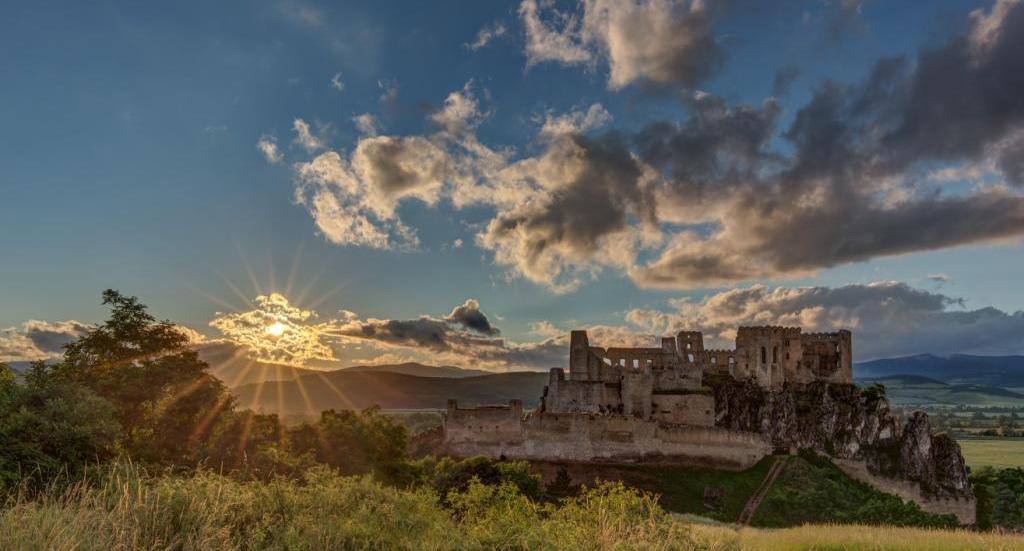


Bradlo is a rocky hill with a stone mound with four pylons, where remains of the First Minister of Defense of the Czechoslovak Republic, Gen. Milan Rastislav Štefánik and his family - Italian soldiers. The white stones shine far away, but as if they were looking to the native village of a significant Slovakian - to Kosarísk. They are from here, not even by stone.
At the top of the county
With Bradl I first met in 1967 when we as students of the Central High School in Trencin wandered to this important place. From the depths of memory, Martin Braxatoris-Sládkovič's poem is the result of this powerful experience:
On Bradle,
on his own ending,
there in hard rock, in the gravel of yellow-gray,
there in a sweet sweater,
sleeping eagle-general,
what a rabbit cracked the barrel.
The question why the great son of the Slovak nation is resting on Bradle brought us to Brezova pod Bradlom, where the Dušan Samuel Jurkovič Memorial Room is located in the National House of Stefanik. Her manager, Martin Valihora, is also the head of the Department of Culture and Local Traditions of Ms Brezová pod Bradlom and the man who controls the history of building a memorial from the first idea, through the realization of the building to the present. The language is a question of why the idea of a native from the nearby Turej Luky Dušan Samuel Jurkovič was realized during the construction of the memorial.
Dušan Jurkovič - father of thought
"During the First World War, Jurkovič had to become a citizen of the Austro-Hungarian Empire," Martin Valihor, the story, began to unfold. "As an architect, he was in charge of building military cemeteries in western Galicia. He chose the district of Žmigród east of Krakow and suggested he built 42 military cemeteries and monuments. He gained great experience with memorial architecture, which he then used to design a mound on Bradle. Its originality consisted in the fact that, unlike other architects, it built those cemeteries out of settlement in the surrounding countryside and countryside. He tried to sensitize architecture to the surrounding countryside, and to work with different materials. Some of the cemeteries made of stone, some of the wood, some in combination of these materials. Already at this time, he was thinking about the memory of the victims of the war in Brezova pod Bradlom. "
The original idea was to build a memorial to honor the uprising in 1848, the Hurban warfare, which was also attended by Jurkovic's family. They built it at the local cemetery and became the last resting place of Dušan Jurkovič.
Based on this idea and his rich experience with the creation of memorial architecture, Jurkovic was able to respond very quickly when he learned about Štefánik's death on May 4, 1919. He was also convinced that this extraordinary person also needs an exceptional place of lasting rest. He proposed, therefore, Bradlo, a hill with an altitude of 543 meters, which is a real dominant of Štefánik's and Jurkovič's birthplace. Jurkovič was convinced that this is an exceptional place for the last hero's last rest.
"Jurkovič came up with the idea of funeral and construction of a memorial even because he proposed Galic war cemeteries. Moreover, he was a native of this region and knew it well. He chose the hill over the countryside, suggested the idea to the family, and received the permission of the surviving Štefániků, even government officials. Jurkovič in May 1919 commissioned the preparation of funeral Štefánik and Italian pilots. He is the father of this idea, he convinced the family and the state authorities and received their consent, "argues Valihora.
Two farewells with an exceptional Stephanic
He planned the funeral within two days and two places. The first day of the funeral of Štefánik and his Italian species was on Saturday, May 10, 1919, in Bratislava - in the new center of Slovakia. It was the first demonstration of the values of the new state. From the crew hospital's premises located in the archbishop's palace (nowadays here, the Office of the Government of the Slovak Republic), he escorted the streets of the city to the railway station. Raky Štefánik and Italian pilots won all the military honors on cannon racks, accompanied by their legionary guardian guard. Behind Štefánikom he walked with the scepter of Charles University. The coffins were loaded on the train, and they were taken to Brezova pod Bradlom on Saturday night. Štefánik's coffin was deposited for the night at the Evangelical Church, a three-year-old coffin at the Catholic Church in Brezova.
On Sunday, May 11, the funeral was continued with Kosarísk and from there to Bradlo, where simple funeral decorations were prepared. It was seven days after Stephen's death. Before that, however, Jurkovič sent to Bradlo soldiers who, using explosives, created a cross-shaped crucifix on the site of the mounds. At the top of the cross was placed the coffin of Štefánik, on three shoulders of the coffin of Italian pilots. Around four squares four pylons were erected. They had a wooden skeleton, they were covered with a black cloth and covered with a clover. They symbolized the four dead. About 30,000 people participated in the funeral, especially from the immediate vicinity. The gathering became the largest event where Slovaks met the national goal. The former monarchy did not allow them to do so either.
Two million crowns from people
According to Martin Valihor, Jurkovic had a very thoughtful idea of the future mound at the funeral. Even the funeral decoration stood at the site of the next mound, where Bradlo ran into the shape of a pyramid, and four pylons appeared. Jurkovič briefly presented the plans for the future mound after the funeral. However, they had to wait for eight years to implement them. This was due to the fact that the budget for the construction had a total sum of CZK 2,800,000. Jurkovič lobbled where he could, he was circumventing the state authorities, he also visited President Masaryk in Lao. The Ministry of Defense, the National Liberation Monument and President Masaryk have combined 800,000 crowns. Missing two million took to collect a mound for collecting a mound from the people and it took eight years for the money to be gathered. The mounds began to build in 1927.
"Dušan Jurkovič of the Canyon suggested that the internal spaces with the body remains are closed and inaccessible, because they felt cruel to the dead. In the exposition, we have plans for a mound and an opening model to see the interior of the tumble, "continues Valihora.
The construction grew admirably quickly when they started working. The huge work is 96 meters long and 70 meters wide and built it in 280 business days. In the stonework of Dreveník in Spiš they travertine mined, and they also worked on a block with precisely defined dimensions. Each stone got its number and carried them to Brezova pod Bradlom. Prior to the start of the construction, they built a road that still serves Bradlo. The mound is travertine lined only by the bell, the pylons of the pylons and the supporting walls of the terrace are made of cast concrete, which greatly accelerated the work. The builders had only one truck, the material helped transport the furmani from the neighborhood. From today's turn, they led to the mound of the railroad lane that they received the material for the construction.
The memorial also survived the normalization
Dušan Jurkovič had another project in his head. He wanted to go to the mound with two terraces that would serve as a memorial to a flight fighter who died in the Second World War. Western resistance has slowly begun to be heard, and this idea has never occurred.
The Socialist regime did not care about the maintenance of this sacred place, and therefore the mayy was not maintained. Its great restoration took place after 1989 and it was necessary to replace 30% of the travertine.
"The memorial celebrations that killed the war were held in the mound and, for the past regime, Štefánik was not a hero. People have begun to rejoin the Bradle at the end of the sixties of the last century, but the onset of the "normalization process" has interrupted the tradition. Only after 1989 was the tradition of May's meetings on Bradle fully restored, "concluded Martin Valihora's compelling narrative.
The exhibition of Dušan Jurkovič's Memorial Room in Brezova pod Bradlom offers a small space of documents and three-dimensional objects, supported by professional interpretation and unrepeatable personal contribution of its leader. She definitely wishes to visit her and spend moments with a memory of the personality, natives of this beautiful region.
author: Leo Kužela

Malebná zrúcanina viditeľná už z diaľky na vápencovo-dolomitickom kopci poskytujúca…

Dominantný a majestátny. Taký je hrad Beckov. Vyrastá zo skaly, je s ňou spätý ako sú s…